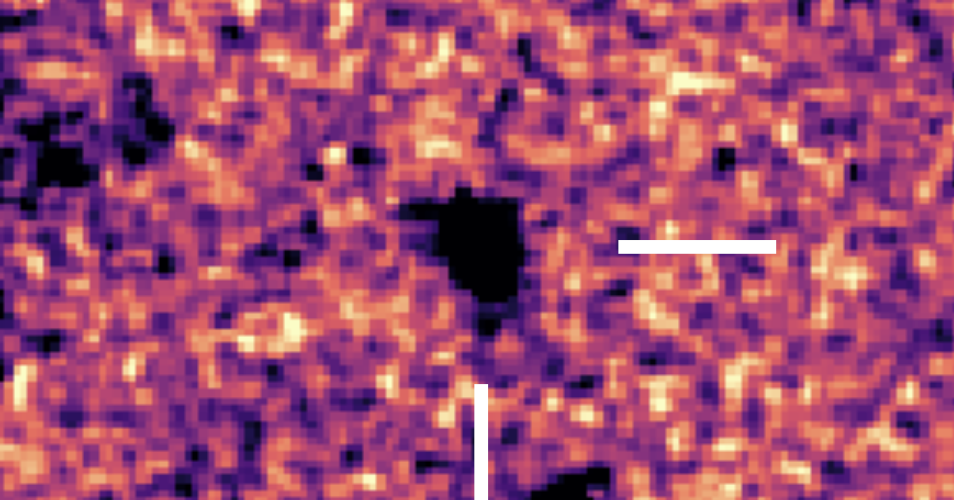James Webb challenges cosmic dawn
— an insight into what's going on in astronomy right now
Since the James Webb Space Telescope last month began releasing its science observations, candidates for increasingly distant galaxies have been reported on a regular basis. In fact, the size and the number of distant galaxies seem to challenge our understanding of how galaxies form. But before insisting that we are facing a cosmological paradigm shift, there is a long list of reservations and alternative explanations which must be considered. Astronomers at the Cosmic Dawn Center in Copenhagen are working intensely on solving this puzzle.

One of the candidates for the hitherto most distant galaxy, GLASS-z11, seen by its infrared light (darker color means more light). Credit: Rohan Naidu & Pascal Oesch.
After half a year of cooling, calibrating, and commissioning its instruments, the James Webb Space Telescope is finally ready for science. From July 14, a steady stream of data has been flowing down to us, and ever since it seems James Webb keeps breaking its record of the most distant galaxy.
Because the most distant galaxy is also the one seen farthest back in time, these observations are not only a matter of breaking a record, but put important constraints on the timescales of the formation of all structure in the Universe, that is galaxy clusters, galaxies, stars, planets, and ultimately ourselves.
A blue whale in a bucket of water
And not only does it seem that we broke the record — even many times. Several researchers around the world are reporting galaxies so massive and bright that they shouldn't have had the time to grow that big since the Big Bang.
Gabriel Brammer, associate professor at the Niels Bohr Institute and the center of excellence Cosmic Dawn Center in Copenhagen, illustrates it in the following way:
"The population of galaxies is in some sense analogous to the population of animals in the sea. There are many plankton, fewer fish, and very few blue whales. Finding a blue whale isn't in itself impossible, but taking a random bucket of water and finding a blue whale is rather remarkable."
Cosmic Dawn
The term "cosmic dawn" is moniker used for the epoch in the history of the Universe, shortly after the birth of the first luminous sources — stars and galaxies — began brightening up the Universe.
Cosmic Dawn Center (DAWN) is a basic research center in astronomy, supported by the Danish National Research Foundation. Researching in particular the earliest galaxies, DAWN is a collaboration between the Niels Bohr Institute at the University of Copenhagen, and at the National Space Institute at the Technical University of Denmark (DTU Space).
Many alternative explanations
Claims of record galaxies and new physics are already seen all around on various news media. But before popping the champagne corks we need to hold our horses for a while, because there are many other possible explanations.
At the Cosmic Dawn Center, Gabriel Brammer and his colleagues are studying exactly these galaxies, both observationally and theoretically. Among the various reservations that must be made are:
In a more in-depth background article, "Galaxies at Cosmic Dawn", we take a closer look at what's going on in astronomy right now, and on each of these alternatives, all described in recent scientific articles from the Cosmic Dawn Center.
More information
Contact
Scientific articles
The studies described in this and the background article have all been submitted to various scientific journals. Preprints are available at the arXiv preprint server:
- Naidu, Oesch, et al. (2022a), Two Remarkably Luminous Galaxy Candidates at z≈11−13 Revealed by JWST, submitted to ApJL.
- Castellano et al. (2022), Early results from GLASS-JWST. III: Galaxy candidates at z∼9-15, submitted to ApJL.
- Naidu, Oesch, et al. (2022b), Schrodinger's Galaxy Candidate: Puzzlingly Luminous at z≈17, or Dusty/Quenched at z≈5?, submitted to ApJL.
- Mason et al. (2022), The brightest galaxies at Cosmic Dawn, submitted to MNRAS.
- Steinhardt et al. (2022), Templates for Fitting Photometry of Ultra-High-Redshift Galaxies, submitted to ApJ.
Danish version
To read this news story in Danish, click here.
Tags: DAWN papers, JWST


